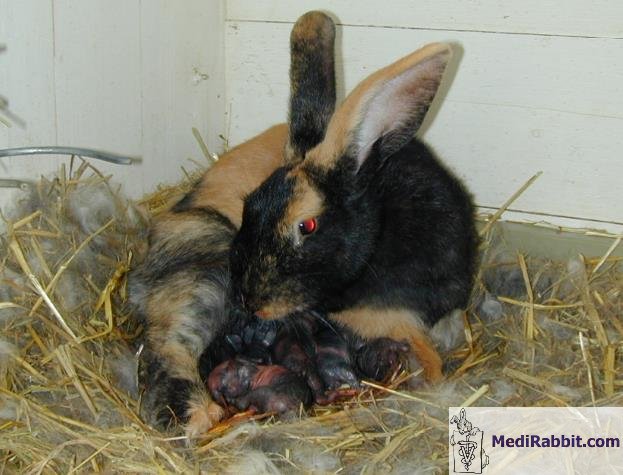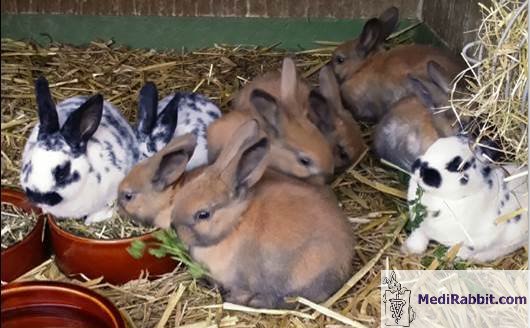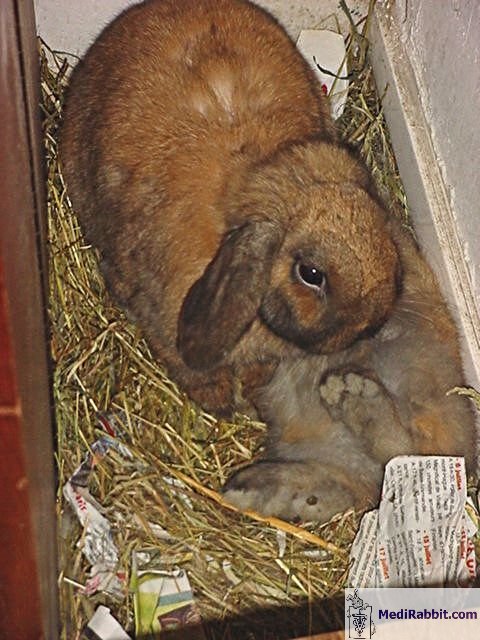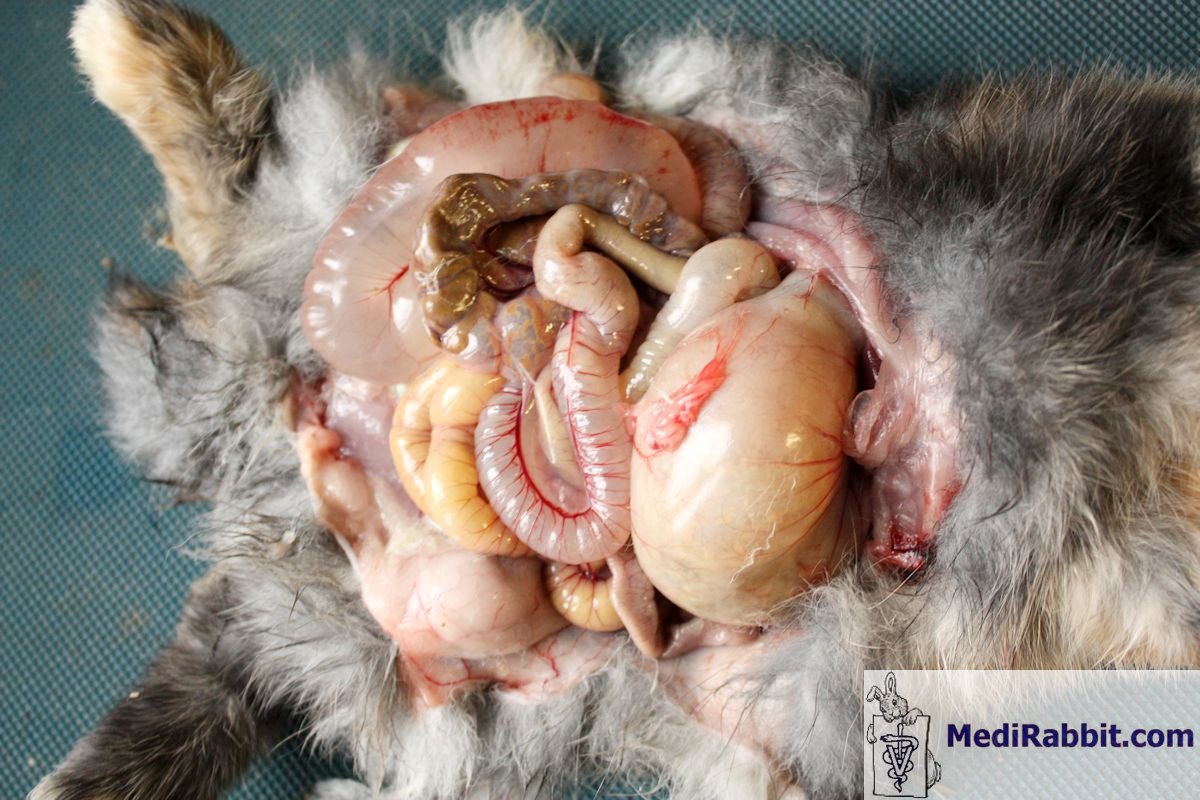Weaning diarrhea in young rabbits
Esther van
Praag, Ph.D.
MediRabbit.com is funded solely by the
generosity of donors.
Every donation, no matter what
the size, is appreciated and will aid in the continuing research of medical care
and health of rabbits.
Thank you
|
|
Some
stages in the life of a rabbit are stressful. The fears or anxieties they
cause can affect the behavior of the rabbit and make it more susceptible to diseases
or infections of bacterial or parasitic origin. The digestive tract is
particularly affected and the consequence is diarrhea and abdominal pain. Weaning is
a delicate phase that determines the development of the digestive system in
young rabbits. The intestine and cecum are gradually invaded by a healthy
bacterial flora. in young weak rabbits, it is often
the pathogenic bacteria that invade the digestive system rather than healthy
bacteria. The age of weaning is also important, as the natural process of
colonization by bacteria takes place between 6 and 8 weeks. Important causes of stress Parturition. It usually lasts less than 15 minutes. This moment
is accompanied by tremendous stress for the doe, especially when parturition
lasts a long time. Newborn that are too weak will have difficulty to reach
rapidly the warm nest prepared by the doe and may, therefore, not drink
enough colostrum milk in sufficient quantity.
Michel Gruaz Harlequin
doe licking her newborn after parturition Weaning. This is a
difficult step for the young rabbit. Physiological weaning begins at 4 weeks
of age. Young rabbits drink less milk and are more and more interested in solid
food. Physical weaning takes place between 6 and 8 weeks of age, while the
doe produces less milk. Physical weaning is stimulated by the doe, as she is
absent from her litter for longer periods of time and feeds less milk to her
offspring. The stress caused by weaning, the new feeding rhythm and the
transition from the doe’s milk to a solid food diet of plant origin are all
reasons to destabilize the digestive system and affect the growth of young
rabbits. An imbalance of intestinal and caecal
bacterial flora (dysbiosis) is accompanied by a
depression of the immune system and a decrease of the resistance to
infectious or parasitic diseases. If this is accompanied by the transport of
the young rabbits or a mix of different litters, the risk of weaning diarrhea
increases rapidly. In the case that young rabbits must be moved, it is best
to take the example of the wild doe rabbit that leaves her young in the nest
and moves to a new place in the burrow. This way, the young rabbits remain in
their familiar environment, while the doe will be brought to her new pen or
hutch, or other living environment. The weaker kits can stay a few more days
with the mother-doe to drink the remaining milk. This also avoids a painful
accumulation of milk in the nipples of the doe.
Michel Gruaz 21
days old rabbits are already interested in solid food Change
of food. A modification of the food affects young rabbits as well as adults. In
order to reduce the stress associated with this change, it is recommended to
proceed slowly, mixing the old food with the new one. Quality of the food is
also important, to avoid any contamination by toxins produced by fungi. The
hay must be of good quality and be provided at will. Transportation. Transportation.
Transport is stressful for rabbits, especially during the weaning period. If,
moreover, the members of different litters are mixed at the time of weaning,
the stress imposed on the rabbits is enormous.
Michel Gruaz Mixed
litter of young rabbits Development of the digestive system in young rabbits The digestive system of the rabbits is
unique in the animal world. The doe feeds her offspring once a day only, for
3 to 5 minutes. Her milk has a relatively high pH (between
5.0 to 6.5) and contains short and medium chain fatty acids. These
fatty acids have antibacterial properties, particularly against Clostridium
perfringens and Escherichia coli. While this should contribute to
a healthy bacterial flora in the gut, this is not the case in rabbits. One
enzymatic component of the doe’s milk will bind with an enzyme found in the
stomach of young rabbits. The result is a fatty acid (oily milk) that
prevents bacterial growth in the digestive system of young people during the
first 21 days of their life.
Debbie While
this 21 days old rabbit kit starts to nibble on hay, it continues to drink
the doe’s milk at the age of 4 weeks. Between
week 3 and week 6, the young rabbit begins to nibble on solid food (pellets,
hay, fresh greenery) as well as the fecal and ceacal droppings that the doe leaves around the nest. The
digestive system of the young rabbit is, however, not enough developed at
this stage to ensure a transition from milk to a solid food diet. Indeed, as
long as it drinks breast milk, the presence of this oily milk will prevent
bacterial growth and colonization of the intestine and the cecum. Once the
youngster drinks less milk, the pH of the stomach will drop to 1-2. During
this phase, the bacteria can multiply and colonize the digestive system.
These are essentially Bacteroides sp., Streptococcus
fecalis and other strict anaerobic bacteria.
These bacteria will be regenerated in these organs through coprophagy. A sensitive caecum Factors
such as stress, a higher than normal acidity, diets too rich in protein or too
low in fiber, or too much solid food available during the weaning period play
an important role. The immune system of rabbits is, furthermore, poorly
developed at this age, not protecting the rabbit against pathogenic bacteria
such as Clostridium sp. or Escherichia coli, against clostridia
or other internal parasites. Finally, the administration of some
antibiotics can also lead to fatal diarrhea in rabbits. The cecum
is an anaerobic and slightly acidic medium because of the fermentation process
that takes place there. The bacteria contained in this organ are very
sensitive to any change: pH, osmotic concentration (osmolarity),
starch concentrations in the diet, but also to stress, e.g., due to an
illness or fear. This particularly affects young rabbits at the age of 4 to
12 weeks, but also elderly rabbits. Stress causes an increase of the
adrenaline (epinephrine) stress hormone in the blood. Adrenaline acts on the
rabbit's alarm center and adrenaline sensitive receptors in the intestine. Consequently,
the peristaltic movement is affected, sometimes even stopped. The cecum
remains partially or completely empty and the pH increases, modifying the
conditions of fermentation. The living conditions of the bacterium Bacteroides sp. degrade and it starts to produce
gas in the caecum and in the intestine.
MediRabbit Barium
studies of affected rabbits show a completed impacted caecum (arrows) Young rabbits
or adult stressed or sick rabbits often ignore their caecotrophes. Their poor
quality is due to disturbances in the cecum, or their smell is abnormal
because of the drugs (antibiotics) administered. In such a case, the rabbit
can receive special probiotic supplements for rabbits. Weaning diarrhea Weaning
diarrhea is a major concern for rabbit breeders. This pathology of the
digestive system is widespread and up to 40 to 100% of a litter can be affected
and die. The
transition to a vegetable diet is not obvious and smooth in young rabbits. They
must understand that only solid food is left to eat and they must get used to
the new tastes. The youngster eats less and loses weight. At the level of the
intestine and the cecum, the bacterial flora must adapt and reorganize in
order to digest food of vegetal origin. Rarely, the bacterial reorganization
can lead to abnormal growth of pathogenic bacteria such as streptococci, Clostridium
perfringens or Escherichia coli, accompanied by the production of bacterial
enterotoxins or other toxic molecules. The latter affect intestinal transit,
bacterial flora and food digestion/absorption. Toxins also circulate in the
blood to vital organs, where they cause more tissue damage. Stress leads to a decrease of the
blood circulation in the digestive system. Lack of oxygen (ischemia) causes
local damage to tissues.
Michel Gruaz
Fully
liquid content in the digestive system of this 24 days old young rabbit Some young
rabbits eat little to no food for the next 24 hours after weaning. There is
little information on the consequences of such fasting on health. Decreased
appetite may cause changes in the lining of the intestine. Studies have shown
that young rabbits that have eaten little for a week show changes in the
structure of the intestine: the intestinal villi (folds of the mucosa and
underlying connective tissue) are shorter and the intestinal crypts are
shallower. The surface of the intestine is smaller and, as a result, the
ability to absorb nutrients contained in the diet is diminished. The growth
of the rabbits is slower than those normally feeds. The
combination of a new food, decreased or stopped
appetite and stress can lead to weaning diarrhea. During an
autopsy, the contents of the intestine and cecum are liquid. Treatment It is very
important to keep young rabbits well hydrated, especially in case of severe
diarrhea. In this case, a sterile physiological solution with electrolytes
must be administered. The solution should be lukewarm, so as not to cause
hypothermia. The
administration of physiological fluids must be accompanied by a food rich in
fiber and hay of good quality. Activated
charcoal is very effective in case of diarrhea. The very fine powder binds
the toxins produced by the pathogenic bacteria. This natural product should
not be given over a long period because it also binds nutrients, vitamins and
other nutrients. Kaolin has a similar effect, absorbing bacteria, toxins,
water and nutrients. As a result, it should only be given to young rabbits
over a short period of time. Pectin,
e.g., contained in apple peels, helps stop diarrhea. Blueberry
or blackcurrant juice or fresh blueberries help fight mild diarrhea and have
a mild disinfecting action. Carob seed powder, pomegranate or green tea all
have strong anti-oxidant properties (polyphenols) that help
restore the intestinal flora and stimulate the immune system. Aromatic
herbs such as oregano (Origanum vulgare),
marjoram (Origanum majorana),
thyme or lavender also have light disinfecting properties, including against Escherichia
coli. Finally,
hygiene is essential, especially in case of diarrhea of bacterial origin. Plants or natural products can help
prevent or stop diarrhea. These are effective aids, which act differently
than veterinary drugs. Warning, they do not replace a veterinary treatment
when it is necessary.
Acknowledgements
Huge thanks to Michel Gruaz (Switzerland) for the interesting discussions about
digestive issues and feeding in young rabbits. Further information
Jones JR, Duff JP. Rabbit
epizootic enterocolitis. Vet Rec. 2001 Oct 27;149(17):532.
Hoop RK, Ehrsam
H, Keller B. 10 years of rabbit autopsy--a review of
frequent disease and mortality causes. Schweiz Arch
Tierheilkd. 1993; 135(6-7):212-6. Tribe GW, Whitbread TJ, Watson
GL. Fatal enteritis in rabbits associated with a spirochaete.
Vet Rec. 1989; 124(22):595. Licois D. Tyzzer's
disease. Ann Rech Vet. 1986; 17(4):363-86. Sinkovics G. Rabbit dysentery: 3.
Diagnostic differentiation. Vet Rec. 1978 Oct 7; 103(15):331-2. Patton NM, Holmes HT, Riggs RJ, Cheeke
PR. Enterotoxemia in rabbits. Lab Anim Sci. 1978; 28(5):536-40. |
||||||||||||||||||||||||||||||||||||||||||||||||||||||||||||||||||||||||||||||||||||||||||||||||||||||||||||
e-mail: info@medirabbit.com










